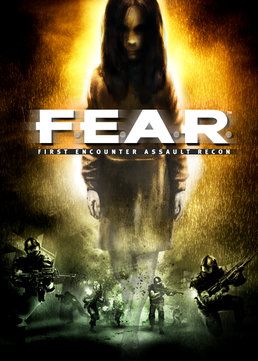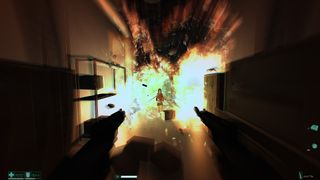Great moments in PC gaming: Slow motion in FEAR
It's bullet-time.
Great moments in PC gaming are bite-sized celebrations of some of our favorite gaming memories.

Developer: Monolith
Publisher: Warner Bros.
Year: 2005
The squads of faceless goons you're fighting in FEAR are smart enough that having an advantage like bullet-time to use against them feels only fair. They'll knock over objects to make cover, leap through windows, throw grenades to flush you out, flank through adjoining rooms, and call out your location with bespoke voice lines—this is a game where someone thought to record "He's behind the pillar!" and "He's behind the column!" separately.
When you defeat these smartasses it's more fun because they're trying so hard. And having all the slowed-down time in the world to see them do their thing means you appreciate their AI more, with all the Half-Life style tricks it pulls to make you think they're acting like real people.
FEAR's slow motion reduces the speed of everything by about five times, but first it doubles your movement and rate of fire. The end result is you're walking while everyone else is crawling, so no matter how smart they seem you've got time to shoot their grenades out of the air or leap over cover and kick them in the face, at which point they fly off in a ragdoll fit.
It also gives you time to appreciate little touches like the volumetric dust that gets kicked up from bullet impacts—clouds of it that only settle when the bullets stop flying—and the smears of blood a shotgun blast reduce someone to, as well as the way bad guys will dead-arm grip their guns, still shooting as they die.

It's a great power fantasy, and yet FEAR is also good at taking that sense of power away from you. It's a horror game as well as an action game, one where a spooky ghost girl right out of The Ring is constantly appearing at the edge of your vision. During one sequence she stalks down a corridor, each object she passes exploding into flame. This happens in slow motion but now it's not empowering—she's bulletproof and all you can do is back away firing wildly in a panic until you're hurled out a window. The slow-mo makes you pay attention to the creepy stuff as well as the cool.
Some of FEAR's fans recommend not using the slow-mo super reflexes for a challenge run, which is fine if you're replaying it, but your first time through you should definitely be hitting Control and running down that meter as much as you can. FEAR's combat is great but part of the reason it's so well-regarded is that it gives players the opportunity to really focus on it, turning you into a football commentator with a finger on the replay button. After you staple someone to a wall you want to say "Let's see that again" and do it to two or three more guys while they shout and swear in slowed-down drawls. FEAR lets you.
The biggest gaming news, reviews and hardware deals
Keep up to date with the most important stories and the best deals, as picked by the PC Gamer team.

Jody's first computer was a Commodore 64, so he remembers having to use a code wheel to play Pool of Radiance. A former music journalist who interviewed everyone from Giorgio Moroder to Trent Reznor, Jody also co-hosted Australia's first radio show about videogames, Zed Games. He's written for Rock Paper Shotgun, The Big Issue, GamesRadar, Zam, Glixel, Five Out of Ten Magazine, and Playboy.com, whose cheques with the bunny logo made for fun conversations at the bank. Jody's first article for PC Gamer was about the audio of Alien Isolation, published in 2015, and since then he's written about why Silent Hill belongs on PC, why Recettear: An Item Shop's Tale is the best fantasy shopkeeper tycoon game, and how weird Lost Ark can get. Jody edited PC Gamer Indie from 2017 to 2018, and he eventually lived up to his promise to play every Warhammer videogame.
Most Popular

